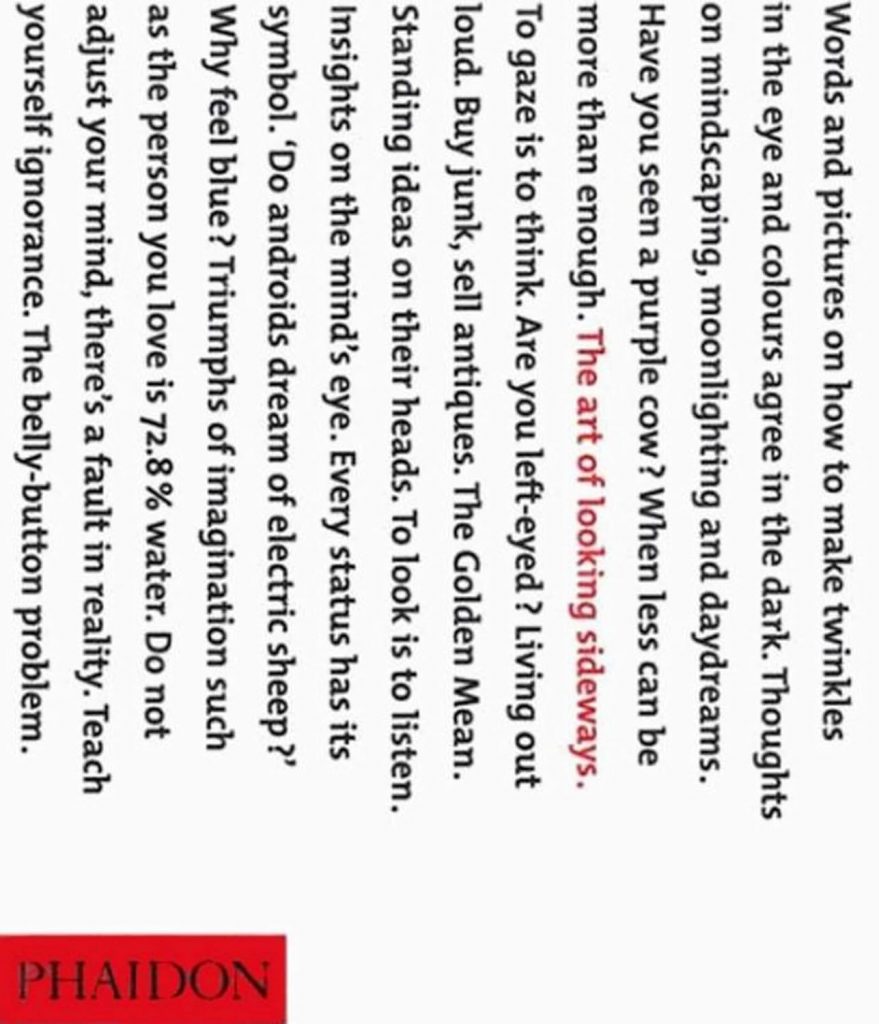
The Art of Looking Sideways is not just a book—it’s an experience. Authored by legendary British graphic designer Alan Fletcher, co-founder of the influential design collective Pentagram, the book was published in 2001 after years of accumulation, reflection, and visual tinkering. Fletcher described it as “a journey without a destination,” and that’s perhaps the best way to approach it: a guided tour through a mind trained to observe, question, and delight in the curious mechanics of visual perception.
Fletcher was known for blending wit, philosophy, and design into a distinctive voice that didn’t merely follow design trends—it helped shape them. This book represents the culmination of decades of creative curiosity. He wanted to create something that would inspire how people think, not just what they think. It’s filled with bits of wisdom, optical illusions, design jokes, color theory, art references, and quotes from everyone from Einstein to Picasso.
What motivated Fletcher was, in many ways, a resistance to convention. He wanted to challenge the reader not just to look, but to look differently. Whether you’re a designer, an artist, or simply a curious human, Fletcher invites you to play, question, and wander off the beaten path of conventional logic and visual experience.
Main Themes
The central theme of The Art of Looking Sideways is perception—how we see, interpret, and make meaning of the visual world. Fletcher masterfully explores the difference between looking and seeing, drawing on everything from neuroscience to Zen philosophy to demonstrate how much of our perception is filtered, biased, or simply habitual.
Another powerful throughline is creative thinking. The book doesn’t aim to teach design in a conventional way; instead, it’s designed to unlock a state of mind. Through juxtaposed images, paradoxical quotes, and visual experiments, Fletcher encourages lateral thinking, randomness, and associative leaps. It’s about learning to embrace ambiguity and contradiction as fuel for the imagination.
Curiosity itself might be the book’s deepest theme. It’s structured like a scrapbook of fascinations—text fragments, image clippings, puzzles, and quotations—all hinting at the joy of simply noticing things. In a way, Fletcher builds a visual argument for living a more observant life: one where every detail might hold a key insight or ironic twist.
Artistic Context
Alan Fletcher’s book didn’t emerge from a vacuum. It’s a product of postmodern design thinking, deeply informed by the modernist graphic design era but thoroughly skeptical of its rigidity. Fletcher began his career in the golden age of Swiss-style typography and grids but grew into a figure who championed intuition, humor, and humanity in design—qualities often left out of modernism’s clean lines and rationality.
In terms of cultural context, The Art of Looking Sideways belongs to a lineage of visual idea books—works like Bruno Munari’s Design as Art or Edward Tufte’s Envisioning Information. Yet Fletcher’s take is far more sprawling, loose, and playful. It reflects the freedom of the late 20th century, where design had begun to escape the studio and enter broader cultural conversations. It’s also a product of pre-digital curiosity—before Pinterest boards and Instagram feeds, books like this offered rare, analog reservoirs of visual stimulation.
Fletcher also situates himself among thinkers like Paul Rand, Marshall McLuhan, and even Marcel Duchamp—artists and intellectuals who weren’t afraid to blend disciplines and use visual language to provoke. While not academic, the book is steeped in art history, psychology, and design theory, but always presented with a wink and a nudge.
Style and Structure
Calling this a “book” is almost misleading. It’s more like a cross between a design monograph, a quote anthology, a scrapbook, and a giant sketchbook. Fletcher ditches traditional chapters and embraces non-linear storytelling. You can pick it up at any page and get pulled into a fresh thread of thought.
Visually, it’s an intricate mosaic. The pages are filled with clippings, drawings, notes, aphorisms, cartoons, and typeset experiments. Some spreads are minimal and meditative, others are overloaded in the best way. Typography is treated not just as a delivery system for words but as a visual material in itself.
The structure reinforces the book’s message: creativity doesn’t obey order. There’s no “right” way to read this. The layout invites exploration and surprise. Fletcher’s visual style—elegant yet unpretentious, witty but never smug—makes even dense ideas feel accessible. This is a book that teaches through form, not just content.
Key Insights and Analysis
One of Fletcher’s most powerful ideas is that the mind thrives on ambiguity. Rather than fearing confusion, he embraces it as a site of potential. Many pages invite us to dwell in uncertainty, reminding us that great ideas often come not from solving a problem, but from reframing the question.
Another recurring insight is the interplay between order and chaos. Design is often about taming disorder, but Fletcher shows how too much control stifles creativity. Through visual games, absurd juxtapositions, and philosophical detours, he makes a case for letting go—trusting intuition, breaking grids, and delighting in the unpredictable.
The book also emphasizes play as a method of thinking. Fletcher doesn’t argue or theorize so much as demonstrate—letting the reader feel the spark of an idea rather than dissecting it. His goal isn’t to explain creativity, but to model it, and that makes this book feel less like a lecture and more like an invitation.
Notable Quotes
Fletcher is a master of the one-liner that lingers. The book is filled with memorable quips, borrowed and original. While we’ll keep it copyright-respectful, here are a few paraphrased highlights that capture the spirit of the book:
- “Confusion is a word we have invented for an order we cannot yet understand.” – a sentiment that recurs often.
- “When you look sideways, things reveal themselves differently.” – the core ethos distilled.
- “Design is not a thing you do. It’s a way of thinking.” – a guiding principle Fletcher shares implicitly throughout.
These moments aren’t just decorative—they’re deliberate provocations, designed to pause your scroll, stop your reading rhythm, and make you reflect.
Who Should Read It?
This book is a must-read for graphic designers, artists, visual thinkers, educators, and really anyone who thrives on ideas. It’s not instructional, so beginners looking for design tutorials might not find immediate utility—but for those looking to reignite creative curiosity, it’s unmatched.
Writers, poets, and even entrepreneurs often find inspiration in its pages. Art historians will appreciate its subtle nods to 20th-century design evolution, while illustrators and layout artists will savor its visual richness. And for anyone feeling creatively blocked, this is the perfect book to shake the dust off your brain.
If you’ve ever clipped a magazine page just because it looked interesting, you’re the target audience.
Final Thoughts & Rating
The Art of Looking Sideways is a rare book that manages to be fun, philosophical, educational, and beautiful—all at once. It resists categorization, which is exactly what makes it such a treasure. Every time you open it, it offers something new. Fletcher gives us a lifelong companion, not a one-time read.
It’s not for everyone—those who crave linearity or step-by-step instruction may find it chaotic—but for the right reader, this book is life-changing. It trains you to see the world not just differently, but more generously.
Rating: 4.9 out of 5




